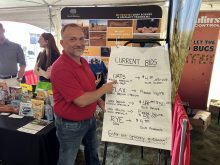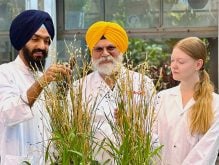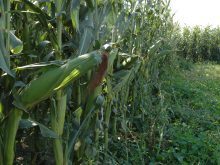Variety development key to robust rotations and sustainable production, but few dollars are allocated to the work
Robust crop rotations are seen by most farmers and many agronomists as the cornerstone of a sustainable crop production system. With a diverse rotation, inputs can be reduced, disease minimized and soil protected.
Soil carbon builds up and production suffers fewer crashes.
But Canada’s oat grower representatives were shocked when they recently talked to Agriculture Canada about the breeding needs of their crop and other small crops.
“They said they do not see a direct link between breeding and sustainability,” said Shawna Mathieson, the executive director of the Prairie Oat Growers Association.
Read Also

Short rapeseed crop may put China in a bind
Industry thinks China’s rapeseed crop is way smaller than the official government estimate. The country’s canola imports will also be down, so there will be a lot of unmet demand.
That means special funding for agricultural research and development that will reduce greenhouse gas emissions doesn’t apply to variety development, regardless of the crop, even if the varieties produced improve a crop’s sustainability.
And supporting variety development of small acreage crops and pulse crops to encourage better rotations than the wheat-canola pattern that is common in some areas, doesn’t compute when it comes to federal funding.
“We do not understand how it could not be part of it,” said Mathieson.
“Rotation is key to sustainability…. We don’t want to become just a two-crop rotation.”
Variety development receives significant federal funding, but it has been proportionately reduced in recent years. Instead of the government covering 75 percent and farmers and industry needing to put up 25 percent, the federal share has been cut to 50 percent, which has doubled the portion that farmers and industry must contribute.
It is possible to get federal funding of up to 70 percent for projects that will reduce greenhouse gas emissions, but variety development doesn’t qualify.
Over the winter, thousands of farmers heard from experts at farm meetings, conferences and shows who said rising pressure to slash carbon emissions from farming will make it difficult to boost per acre production while also reducing emissions.
Most farmers and people in the agriculture industry support a move to lower per-bushel emissions, which are already occurring and for which there is much more potential, but the federal government’s commitment to a harder cap based on emissions per acre might be impossible to pair with substantially increased production.
Prairie farming is generally considered to be more environmentally sustainable than it was 40 years ago with soil erosion mostly prevented by the switch to minimum till farming. However, the addition of pulse crops to the Western Canadian crop roster is also considered to have had a major positive impact on crop farming efficiency and sustainability.
“Teams of researchers with Agriculture and Agri-Food Canada across the Prairies using long-term field studies have shown total grain production, protein production and efficiency of nitrogen utilization in crop production to be improved by including pulses such as field pea, lentil and chickpea,” said University of Manitoba soil scientist Mario Tenuta in a summary of his view published by the Manitoba Pulse and Soybean Growers.
“The benefits stem from pulses contributing to less summerfallow, free nitrogen from the legumes, and increasing rotation lengths to reduce disease issues.”
Pulse crops have had enormous impact on emissions reductions, he said.
“In total, 0.9 million metric tonnes of nitrogen are produced by legumes across Canada annually. That is equivalent to 90 percent of the synthetic nitrogen fertilizer used in Saskatchewan in a year.”
Non-pulse smaller acreage crops have traditionally played a big role in prairie farming sustainability by weakening the disease, insect and weed pressures that can become overwhelming in too-tight rotations, like many believe wheat-canola to be. Canola production is already suffering from major challenges from blackleg and clubroot, flea beetles and herbicide resistant weeds.
Having a pulse crop in the rotation adds nitrogen, reduces diseases, insects and weeds. Having any of the other small acreage crops also in the rotation further helps break the chains of disease, pests and weeds.
Farmers know this, and most farmers believe in the value of a multi-crop rotation. However, many have found they can’t afford to grow pulses or other small crops because the returns are too poor. While canola returns have bounded ahead, the smaller crops can’t offer the promise of a profit, as they fall further and further behind advances in big continental crops like canola, corn, soybeans and wheat.
Pulses play less of a role in many farmers’ rotations because of chronic problems with diseases like aphanomyces, for which solutions have been slow to appear. With much less money available for pulse variety development, coming up with solutions is more challenging than it is for the bigger crops like canola, where substantial industry money is invested.
For the other crops, like oats and flax, maintaining existing research programs is a constant struggle. Trying to keep up with the gains in crops like canola is a herculean task. Catching up to their level of attractiveness to farmers can seem impossible.
Oats seems like a huge industry, with millers operating major plants on the Prairies, oat-based foods like Cheerios, breakfast bars and oat “milk” taking a prominent place on most consumers’ shelves, and farmers growing millions of acres, but compared to the North American giants like corn, soybeans and wheat, or Canada’s dominant crop of canola, it’s one of the little ones.
Even though the industry is worth about $8 billion per year in economic activity, the resources to develop the base crop are tiny.
According to Mathieson, there are “only two-and-a-half” oat breeders in Canada. Since Canada is the number one global exporter of oats, farmers need to have the best varieties to compete, but with so few breeders, it’s hard to develop anything near what the industry needs to stay competitive.
“We can’t afford to lose those breeding programs if we want to stay in the rotations of Canadian farmers,” said Mathieson.
For all the small crops, getting attention and funding for their seed development needs has been equally vexing. It has been common talk in small crop circles for years.
It is particularly frustrating now, as the federal government pushes sustainability and talks about emissions reduction, while refusing to see smaller crops’ role in achieving federal goals.
“It could lead to a two-crop rotation, which does not match the sustainability goals of the government,” said Mathieson.
















